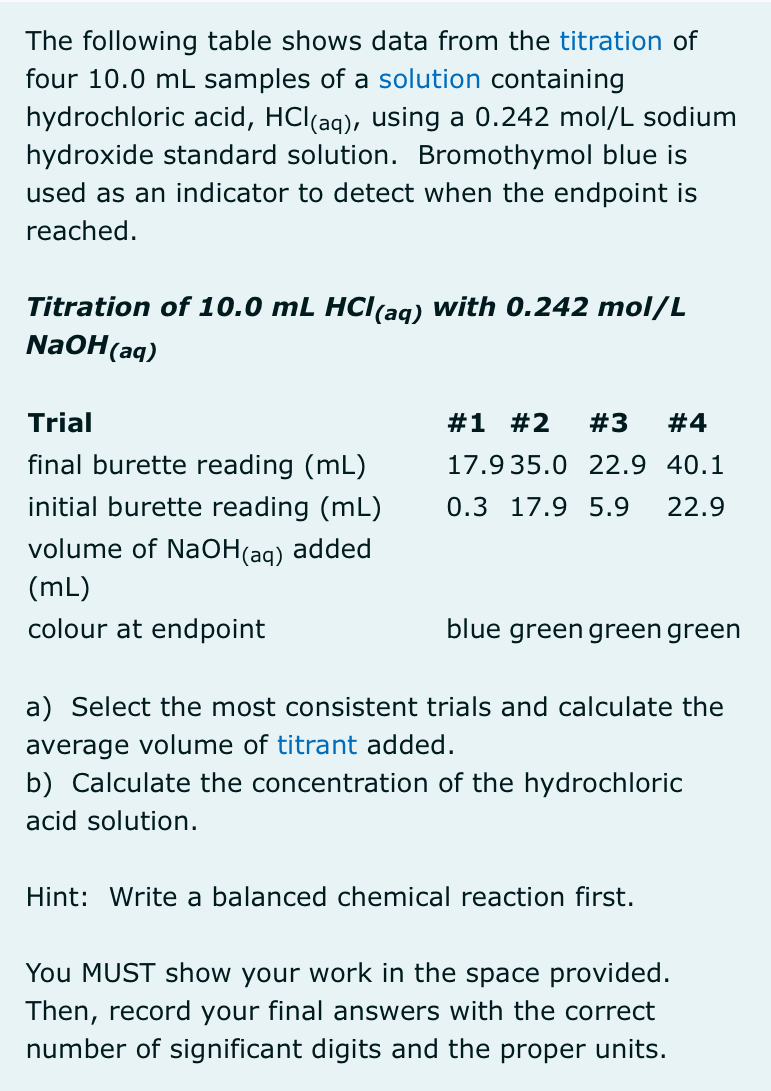a) Select the most consistent trials and calculate the average volume of titrant added. b) Calculate the concentration of the hydrochloric acid solution. Hint: Write a balanced chemical reaction first.
a) Select the most consistent trials and calculate the average volume of titrant added. b) Calculate the concentration of the hydrochloric acid solution. Hint: Write a balanced chemical reaction first.
Chapter15: Acid-base Equilibria
Section: Chapter Questions
Problem 13Q: An acid is titrated with NaOH. The following beakers are illustrations of the contents of the beaker...
Related questions
Question

Transcribed Image Text:The following table shows data from the titration of
four 10.0 mL samples of a solution containing
hydrochloric acid, HCl(aq), using a 0.242 mol/L sodium
hydroxide standard solution. Bromothymol blue is
used as an indicator to detect when the endpoint is
reached.
Titration of 10.0 mL HCl(aq) with 0.242 mol/L
NaOH(aq)
Trial
final burette reading (mL)
initial burette reading (mL)
volume of NaOH(aq) added
(mL)
colour at endpoint
#1 #2 #3 #4
17.935.0 22.9 40.1
0.3 17.9 5.9 22.9
blue green green green
a) Select the most consistent trials and calculate the
average volume of titrant added.
b) Calculate the concentration of the hydrochloric
acid solution.
Hint: Write a balanced chemical reaction first.
You MUST show your work in the space provided.
Then, record your final answers with the correct
number of significant digits and the proper units.
Expert Solution
This question has been solved!
Explore an expertly crafted, step-by-step solution for a thorough understanding of key concepts.
Step by step
Solved in 3 steps with 3 images

Knowledge Booster
Learn more about
Need a deep-dive on the concept behind this application? Look no further. Learn more about this topic, chemistry and related others by exploring similar questions and additional content below.Recommended textbooks for you


Chemistry: An Atoms First Approach
Chemistry
ISBN:
9781305079243
Author:
Steven S. Zumdahl, Susan A. Zumdahl
Publisher:
Cengage Learning

Chemistry
Chemistry
ISBN:
9781305957404
Author:
Steven S. Zumdahl, Susan A. Zumdahl, Donald J. DeCoste
Publisher:
Cengage Learning


Chemistry: An Atoms First Approach
Chemistry
ISBN:
9781305079243
Author:
Steven S. Zumdahl, Susan A. Zumdahl
Publisher:
Cengage Learning

Chemistry
Chemistry
ISBN:
9781305957404
Author:
Steven S. Zumdahl, Susan A. Zumdahl, Donald J. DeCoste
Publisher:
Cengage Learning

Chemistry: Principles and Practice
Chemistry
ISBN:
9780534420123
Author:
Daniel L. Reger, Scott R. Goode, David W. Ball, Edward Mercer
Publisher:
Cengage Learning

Chemistry & Chemical Reactivity
Chemistry
ISBN:
9781337399074
Author:
John C. Kotz, Paul M. Treichel, John Townsend, David Treichel
Publisher:
Cengage Learning

Chemistry & Chemical Reactivity
Chemistry
ISBN:
9781133949640
Author:
John C. Kotz, Paul M. Treichel, John Townsend, David Treichel
Publisher:
Cengage Learning